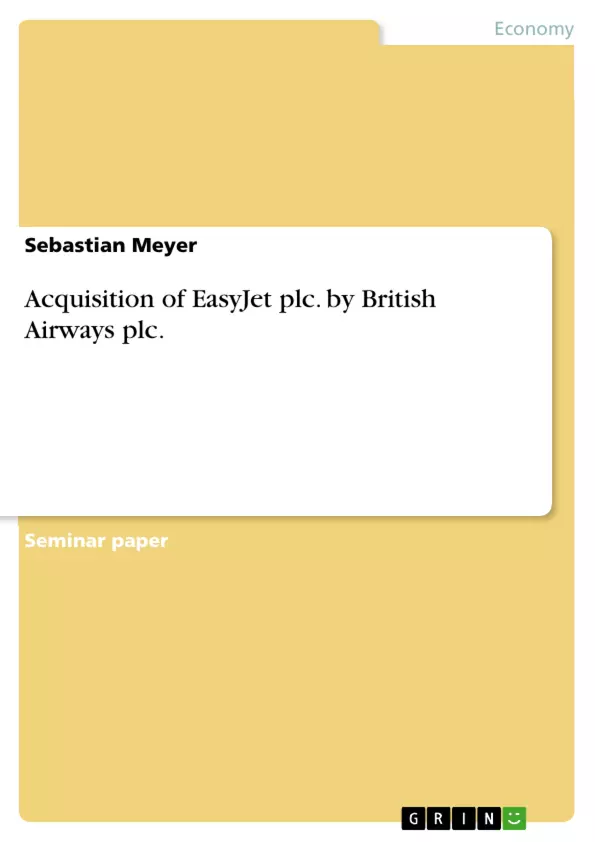The present assignment should formulate a proposal concerning a major strategy change of British Airways, which will be in our case the acquisition of the low-cost carrier Easy Jet. After the formulation of the major strategy change proposal, this work provides an implementation plan as well as a strategic management plan
Table of Contents
- 1. Introduction
- 2. Major Strategy Change Proposal
- 2.1. Nature and Content
- 2.1.1. Reaffirmation of practical nature of proposal
- 2.1.2. Generic Basis of Competition
- 2.1.3. Strategic Direction and Risk/Reward
- 2.1.4. Implementation Method
- 2.2. Justification
- 2.2.1. Suitability
- 2.2.2. Acceptability
- 2.2.3. Feasibility
- 2.1. Nature and Content
- 3. Implementation Plan
- 4. Strategic Management Process
- 4.1. Current Strategy Process
- 4.2. Reasoned Proposals for Change in Process
Objectives and Key Themes
The objective of this assignment is to formulate a proposal for a major strategic change for British Airways: the acquisition of EasyJet. This includes outlining the nature of the proposal, justifying its implementation, and detailing an implementation plan alongside a revised strategic management process.
- Acquisition of EasyJet by British Airways as a strategic move.
- Analysis of competitive strategies within the low-cost airline market.
- Evaluation of the risks and rewards associated with market development.
- Development of an implementation plan using a mergers and acquisitions approach.
- Proposed changes to British Airways' strategic management process.
Chapter Summaries
1. Introduction: This introductory chapter sets the stage for the assignment, outlining the proposal to analyze the acquisition of EasyJet by British Airways as a significant strategic shift for British Airways. It briefly previews the structure of the assignment, indicating that it will encompass the formulation of a major strategy change proposal, an implementation plan, and a review of the strategic management process.
2. Major Strategy Change Proposal: This chapter presents a detailed proposal for British Airways to acquire EasyJet. It begins by emphasizing the growing competition and predicted consolidation within the European low-cost airline market. The proposal suggests that the acquisition will allow British Airways to capitalize on this growing market and rectify a past mistake (the sale of Go Air to EasyJet). The chapter then examines the proposal through Porter's generic strategies, opting for a cost focus strategy due to British Airways' strong reputation and the need to maintain higher standards than competitors while still operating within a cost-conscious model. Further, utilizing Ansoff's Product-Market Matrix, the acquisition is categorized as market development, with associated medium-to-high risks and substantial rewards, including market expansion and synergy potential. Finally, the chapter details the proposed implementation method as a merger and acquisition, choosing acquisition to ensure complete control of EasyJet.
Keywords
British Airways, EasyJet, low-cost carriers, airline industry, mergers and acquisitions, strategic management, market development, cost focus strategy, risk assessment, implementation plan, competitive advantage.
Frequently Asked Questions: British Airways Acquisition of EasyJet Proposal
What is the main topic of this document?
This document presents a comprehensive proposal for British Airways to acquire EasyJet. It analyzes the strategic rationale behind this acquisition, details an implementation plan, and proposes changes to British Airways' strategic management process.
What are the key objectives of the proposed acquisition?
The main objectives are to capitalize on the growing European low-cost airline market, rectify a past strategic mistake (the sale of Go Air to EasyJet), and achieve market expansion and synergies.
What strategic framework is used to analyze the acquisition?
The proposal utilizes Porter's generic strategies (specifically, a cost focus strategy) and Ansoff's Product-Market Matrix (categorizing the acquisition as market development).
What are the identified risks and rewards associated with the acquisition?
The acquisition is deemed to carry medium-to-high risks, but also offers substantial rewards, including market share expansion and potential synergies.
What is the proposed implementation method?
The proposed implementation method is a merger and acquisition, with a preference for acquisition to ensure complete control of EasyJet.
What aspects of British Airways' strategic management process are addressed?
The document proposes changes to the existing strategic management process to better accommodate and support major acquisitions and strategic shifts like this one.
What are the key chapters included in the document?
The document includes an introduction, a detailed proposal for the acquisition, an implementation plan, and an analysis of the strategic management process. Each chapter is summarized within the document.
What are the key themes explored in the document?
Key themes include competitive strategies in the low-cost airline market, risk and reward assessment in market development, mergers and acquisitions, and the importance of a well-defined strategic management process.
What are the keywords associated with this proposal?
British Airways, EasyJet, low-cost carriers, airline industry, mergers and acquisitions, strategic management, market development, cost focus strategy, risk assessment, implementation plan, competitive advantage.
What is the overall structure of the document?
The document provides a table of contents, objectives and key themes, chapter summaries, and keywords to aid comprehension and navigation. It follows a structured and professional approach to analyzing the themes.
What is the intended audience for this document?
The intended audience is academic, focusing on the analysis of themes related to strategic management and business acquisitions.
- Arbeit zitieren
- B.A. Sebastian Meyer (Autor:in), 2004, Acquisition of EasyJet plc. by British Airways plc., München, GRIN Verlag, https://www.grin.com/document/75508



